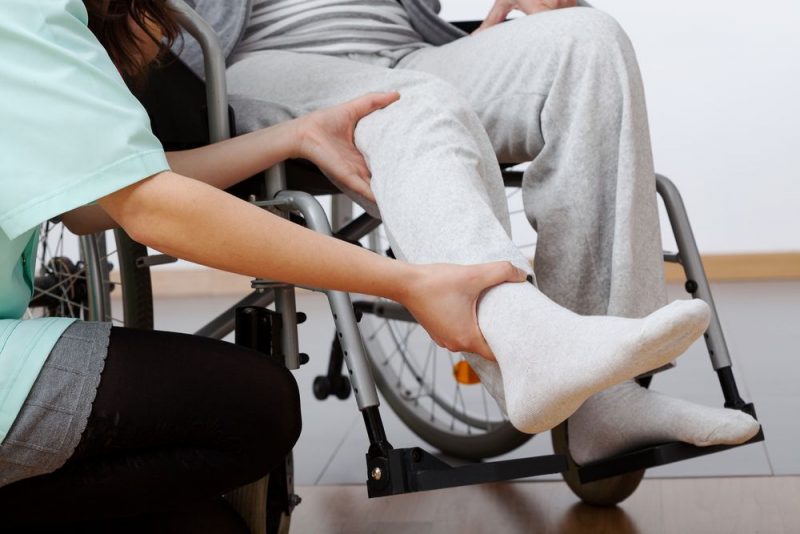‘Wearable Cyborg’ Helps Improve Walking Ability, Muscle Strength

A wearable cybernetic leg significantly improved the gait and ability to perform walking exercises of people with neuromuscular disorders, such as spinal muscular atrophy (SMA), as compared to a conventional hoist, according to a recent clinical trial.
The trial’s results were published in an article, titled “Cybernic treatment with wearable cyborg Hybrid Assistive Limb (HAL) improves ambulatory function in patients with slowly progressive rare neuromuscular diseases: a multicentre, randomised, controlled crossover trial for efficacy and safety (NCY-3001),” in the Orphanet Journal of Rare Diseases.
SMA and other neuromuscular disorders involve damage to motor neurons — those controlling voluntary movements — and the muscles they connect to, collectively called the “motor unit.” As part of the central nervous system (CNS, comprising the brain and spinal cord), damage to these neurons is considered irreversible and rehabilitation programs largely focus on developing ways to compensate for lost function, while slowing further loss.
While curative treatments tend to focus on targeting the disorders’ underlying causes, the chance that these will restore lost motor function is considered unlikely, prompting a need for restorative therapies.
To this end, a team of researchers from various Japanese institutions developed an exoskeletal robot named HAL (Hybrid Assistive Limb). The device is an example of “cybernics,” which the scientists describe as a “fusion of humans, robots, and information systems.”
“Cybernics technology,” they wrote, “links the human nervous system and a robot through bioelectric signals such as motor unit potentials, which results in a dynamic state in which the wearer and HAL are functionally and physically connected.”
Essentially, HAL is designed to function as a part of its wearer’s body, by responding to the user’s thoughts through a process called interactive biofeedback (iBF). The team hopes that the iBF between HAL and its users will lead to the regeneration of impaired motor function. This regeneration is also known as neuroplasticity.
To test this, the investigators conducted a clinical trial (NCY-3001) to test whether iBF works safely and effectively when motor neurons are damaged.
The main goal was to evaluate changes in the two-minute walk test (2MWT), with secondary goals of measuring changes in walking speed, cadence, and step length in the 10-meter walk test (10MWT), as well as muscle strength (measured by manual muscle testing), and several other functional measures.
The study recruited 24 volunteers representing a range of neuromuscular disorders, five of whom had SMA and were between the ages of 48 and 59. Participants were unable to walk over 10 meters independently and did not have respiratory failure or rapid gait deterioration.
After an initial four-week pre-observation period, investigators randomized patients to receive HAL plus a conventional hoist or the hoist only for 13 weeks, after which each participant switched to the other treatment. During the treatment periods, the volunteers performed nine 40-minute walking sessions. This was followed by a four-week post-observation period.
Overall, the use of HAL was associated with a significant improvement of 10.066% in the 2MWT, as compared to the hoist only. Cadence during the 10MWT also showed significant improvements. Changes in speed, while “substantial,” did not rise to statistical significance, and step length did not significantly change.
Finally, total scores in manual muscle testing showed significant improvement after cybernic treatment, which the researchers described as “groundbreaking.”
Adverse effects were reported among 55.2% of people during hoist-only treatments and among 80% during HAL sessions. All events were mild and approximately half consisted of muscle soreness, back pain, joint soreness, pain in the extremities, and arthritis, all associated with the walking programs.
Other common side effects included skin irritation, redness, and exfoliation at the contact sites used for HAL’s electrodes and cuffs.
“Our findings,” the researchers concluded, “set a precedent for replacing existing walking exercise therapy using a hoist or treadmill alone with cybernic treatment using HAL.”
The team is planning a second clinical trial to confirm whether iBF can induce neuroplasticity in CNS lesions.
“The efficacy of iBF-based cybernic treatment,” they wrote, “will be undoubtedly verified by integrating the results of our next trial on spastic paraplegia caused by CNS lesions with those of the present study.”
HAL, developed by Cyberdyne, is produced in Japan and distributed in the EU under the name HAL-ML05. It has received quality management system-related approvals as a robotic medical device.
The post ‘Wearable Cyborg’ Helps Improve Walking Ability, Muscle Strength appeared first on SMA News Today.




